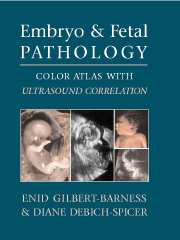Book contents
- Frontmatter
- Contents
- Foreword by John M. Opitz
- Preface
- Acknowledgments
- 1 The Human Embryo and Embryonic Growth Disorganization
- 2 Late Fetal Death, Stillbirth, and Neonatal Death
- 3 Fetal Autopsy
- 4 Ultrasound of Embryo and Fetus: General Principles
- 5 Abnormalities of Placenta
- 6 Chromosomal Abnormalities in the Embryo and Fetus
- 7 Terminology of Errors of Morphogenesis
- 8 Malformation Syndromes
- 9 Dysplasias
- 10 Disruptions and Amnion Rupture Sequence
- 11 Intrauterine Growth Retardation
- 12 Fetal Hydrops and Cystic Hygroma
- 13 Central Nervous System Defects
- 14 Craniofacial Defects
- 15 Skeletal Abnormalities
- 16 Cardiovascular System Defects
- 17 Respiratory System
- 18 Gastrointestinal Tract and Liver
- 19 Genito-Urinary System
- 20 Congenital Tumors
- 21 Fetal and Neonatal Skin Disorders
- 22 Intrauterine Infection
- 23 Multiple Gestations and Conjoined Twins
- 24 Metabolic Diseases
- Appendices
- Index
14 - Craniofacial Defects
Published online by Cambridge University Press: 23 February 2010
- Frontmatter
- Contents
- Foreword by John M. Opitz
- Preface
- Acknowledgments
- 1 The Human Embryo and Embryonic Growth Disorganization
- 2 Late Fetal Death, Stillbirth, and Neonatal Death
- 3 Fetal Autopsy
- 4 Ultrasound of Embryo and Fetus: General Principles
- 5 Abnormalities of Placenta
- 6 Chromosomal Abnormalities in the Embryo and Fetus
- 7 Terminology of Errors of Morphogenesis
- 8 Malformation Syndromes
- 9 Dysplasias
- 10 Disruptions and Amnion Rupture Sequence
- 11 Intrauterine Growth Retardation
- 12 Fetal Hydrops and Cystic Hygroma
- 13 Central Nervous System Defects
- 14 Craniofacial Defects
- 15 Skeletal Abnormalities
- 16 Cardiovascular System Defects
- 17 Respiratory System
- 18 Gastrointestinal Tract and Liver
- 19 Genito-Urinary System
- 20 Congenital Tumors
- 21 Fetal and Neonatal Skin Disorders
- 22 Intrauterine Infection
- 23 Multiple Gestations and Conjoined Twins
- 24 Metabolic Diseases
- Appendices
- Index
Summary
The source of developmental anomalies lies within deviations from the normal pathways of embryogenesis.
Early stages ofembryonic development can be studiedby identification of developmental genes and their products, using in situhybridization and immuno chemistry and computerized three-dimensional reconstruction of aborted sectioned human embryos.
OROFACIAL CLEFTS
The most frequent craniofacial anomalies are clefts of the upper lip and palate that can now be diagnosed prenatally.
Cleft Lip
Clefts of the lip and palate are among the most common congenital anomalies, occurring in ±1.7 per 1,000 births in Asians, approximately 1 per 1,000 Caucasian births, and approximately 1 per 2,500 births in those of African lineage (Figures 14.1 to 14.5 and Tables 14.1 and 14.2). The frequency of cleft lip /palate is highest in Native Americans, occurring in over 3.6 per 1,000 births and showing a 2:1 female-to-male frequency. Unilateral cleft lips are more frequent on the left than the right and are least frequent bilaterally in the respective ratios of 6:3:1. Isolated cleft palate is distinguished from combined cleft lip and palate; the former occurs about twice as frequently as the combination. Some 2050% of cleft palates are associated with other anomalies. About 5% of facial clefting is syndromic, with over 250 cleft-associated syndromes.
Pathology of Cleft Lip. If the embryo is examined shortly after Carnegie Stage 18 and autolysis is severe, the newly fused tissue may degenerate and an artifactual cleft may appear. Thus, cleft lip cannot be diagnosed in a severely autolyzed embryo.
- Type
- Chapter
- Information
- Embryo and Fetal PathologyColor Atlas with Ultrasound Correlation, pp. 367 - 387Publisher: Cambridge University PressPrint publication year: 2004



